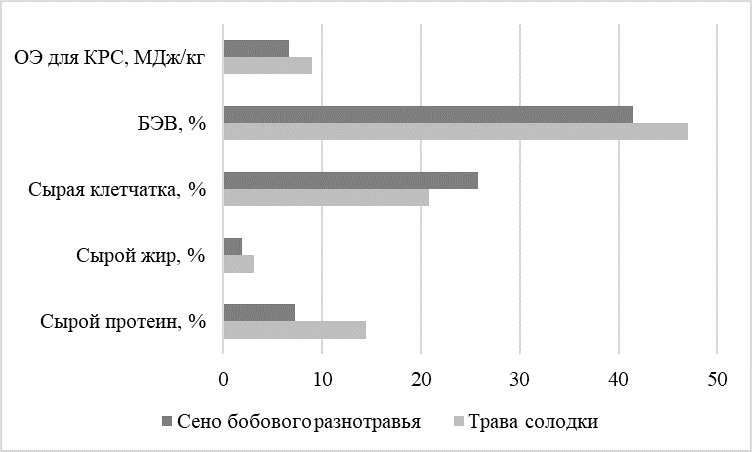АМИНОКИСЛОТНЫЙ СОСТАВ И КОРМОВАЯ ЦЕННОСТЬ ТРАВЫ GLYCYRRHIZA PALLIDIFLORA MAXIM., ИНТРОДУЦИРОВАННОЙ В КУЗБАССЕ
УДК 581.6:633.31/37:631.963
Аннотация
Цель работы – изучение аминокислотного состава и кормовой ценности травы солодки бледноцветковой (Glycyrrhiza pallidiflora Maxim.) семейства Бобовые (Fabaceae), интродуцированной в Кузбассе. В сырье третьего и четвертого года интродукции идентифицировано восемнадцать протеиногенных аминокислот. Из них восемь незаменимых и десять заменимых. Суммарное содержание аминокислот существенно отличалось по годам и составляло в третьем году 6.266±0.89%, в четвертом – 12.541±0.51%. Сильнее по годам варьировало содержание триптофана, аргинина, лейцина+изолейцина, валина, гистидина, аспарагиновой кислоты, серина. Слабее – пролина, тирозина, метионина. Преобладают аминокислоты с полярными отрицательно заряженными радикалами (кислые). Их доля от общего содержания аминокислот в среднем составляет 36.20%. Несколько уступают аминокислоты с неполярными радикалами (нейтральные) – 31.80%. Наименьший удельный вес имели аминокислоты с полярными положительно заряженными радикалами (основные) 11.85%. Большей долей от суммы аминокислот характеризовались аспарагиновая и глютаминовая кислоты, лейцин+изолейцин, аргинин, серин, пролин.
Содержание сырого жира, протеина, золы, протеина по Барнштейну, безазотистых экстрактивных веществ (БЭВ) и фосфора достигало наибольших значений на третий и четвертый годы. Количество сырой клетчатки и кальция снижалось с увеличением возраста растений. Обменная энергия и энергетические кормовые единицы по сырым питательным веществам для крупного рогатого скота (КРС) в среднем составили соответственно 8.98 МДж/кг и 0.90. Наибольших значений достигали на третий и четвертый годы культивирования. Таким образом, трава солодки бледноцветковой является перспективным растением в качестве кормовой культуры и для приготовления кормовых добавок.
Скачивания
Metrics
Литература
Kosolapov V.M. Zemledeliye, 2009, no. 6, pp. 3–5. (in Russ.).
Richards N., Nielsen B.D., Finno C.J. Vet. Clin. North Am. Equine Pract., 2021, vol. 37(1), pp. 43–61. DOI: 10.1016/j.cveq.2020.12.002.
Degtyareva I.A., Gasimova G.A. Uchenyye zapiski Kazanskoy gosudarstvennoy akademii veterinarnoy meditsiny im. N.E. Baumana, 2015, no. 223, pp. 58–61. (in Russ.).
Wanapat M., Cherdthong A., Phesatcha K., Kang S. Anim. Nutr., 2015, vol. 1(3), pp. 96–103. DOI: 10.1016/j.aninu.2015.07.004.
Halmemies-Beauchet-Filleau A., Rinne M., Lamminen M., Mapato C., Ampapon T., Wanapat M., Vanhatalo A. Ani-mal, 2018, vol. 12(2), pp. 295–309. DOI: 10.1017/S1751731118002252.
Romanov V.N., Bogolyubova I.V. Veterinariya, zootekhniya, biotekhnologiya, 2018, no. 6, pp. 75–83. (in Russ.).
Voronov I.V. Khimiya Rastitel'nogo Syr'ya, 2018, no. 3, pp. 69–74. DOI: 10.14258/jcprm.2018033610. (in Russ.).
De Angelis A., Gasco L., Parisi G., Danieli P.P. Animals, 2021, vol. 11, p. 2230. DOI: 10.3390/ani11082230.
Putri E.M., Zain M., Warly L., Hermon H. Vet. World, 2019, vol. 12(9), pp. 1478–1483, DOI: 10.14202/vetworld.2019.1478-1483.
Broderick G.A. J. Dairy Sci., 2018, vol. 101(2), pp. 1190–1205. DOI: 10.3168/jds.2017-13690.
Meng Z., Liu Q., Zhang Y., Chen J., Sun Z., Ren C., Zhang Z., Cheng X., Huang Y. Food Sci. Nutr., 2021, vol. 22 (9), pp. 5244–5262. DOI: 10.1002/fsn3.2342.
Tolstikov G.N., Baltina L.A., Grankina V.P. et al. Solodka: bioraznoobraziye, khimiya, primeneniye v meditsine. [Lico-rice: biodiversity, chemistry, application in medicine]. Novosibirsk, 2007, 316 p. (in Russ.).
Sapozhnikova T.G. Redkiye sosudistyye rasteniya Khabarovskogo kraya i ikh okhrana. [Rare vascular plants of the Khabarovsk Territory and their protection]. Vladivostok, 1997, 31 p. (in Russ.).
Klyuchnikova N.F., Klyuchnikov M.T., Klyuchnikova Ye.M. Yevraziyskiy soyuz uchenykh, 2014, no. 8, pp. 12–13. (in Russ.).
Klyuchnikova N.F., Klyuchnikov M.T. Vestnik DVO RAN, 2016, no. 2, pp. 113–115. (in Russ.).
Liu J.H., Yang S.S., Fu Y.Q., Yuan C.L., Liu B. Acta pharmaceutica Sinica, 1990, vol. 25(9), pp. 689–693.
Shults E.E., Shakirov M.M., Pokrovsky M.A., Petrova T.N., Pokrovsky A.G., Gorovoy P.G. Nat. Prod. Res., 2017, vol. 31(4), pp. 445–452. DOI: 10.1080/14786419.2016.1188094.
Rastitel'nyye resursy Rossii: dikorastushchiye tsvetkovyye rasteniya, ikh komponentnyy sostav i biologicheskaya ak-tivnost'. T. 3. Semeystva Fabaceae – Apiaceae. [Plant resources of Russia: wild flowering plants, their composition and biological activity. Vol. 3. Fabaceae – Apiaceae families], ed. A.L. Budantsev. St. Petersburg, Moscow, 2010, pp. 40–41. (in Russ.).
Pinchuk L.G., Mal'tseva Ye.M., Yegorova I.N. Mediko-farmatsevticheskiy zhurnal "Pul's", 2021, vol. 23, no. 5, pp. 29–34. DOI: 10.26787/nydha-2686-6838-2021-23-5-29-34. (in Russ.).
GOST R 55569-2013. Korma, kombikorma, kombikormovoye syr'ye. Opredeleniye proteinogennykh aminokislot metodom kapillyarnogo elektroforeza. [GOST R 55569-2013. Feed, compound feed, compound feed raw materials. Determination of proteinogenic amino acids by capillary electrophoresis]. Moscow, 2014, 19 p. (in Russ.).
Biokhimiya. [Biochemistry], ed. Ye.S. Severin. Moscow, 2003, 779 p. (in Russ.).
Kirilov M.P., Makhayev Ye.A., Pervov N.G., Puzakova V.V., Anikin A.S. Metodika rascheta obmennoy energii v kormakh na osnovy soderzhaniyu syrykh pitatel'nykh veshchestv. [Methodology for calculating the metabolic energy in feed on the basis of the content of raw nutrients]. Dubrovna, 2008, 30 p. (in Russ.).

Copyright (c) 2023 Химия растительного сырья

Это произведение доступно по лицензии Creative Commons «Attribution» («Атрибуция») 4.0 Всемирная.

This work is licensed under a Creative Commons Attribution 4.0 International License.
Авторы, которые публикуются в данном журнале, соглашаются со следующими условиями:
1. Авторы сохраняют за собой авторские права на работу и передают журналу право первой публикации вместе с работой, одновременно лицензируя ее на условиях Creative Commons Attribution License, которая позволяет другим распространять данную работу с обязательным указанием авторства данной работы и ссылкой на оригинальную публикацию в этом журнале.
2. Авторы сохраняют право заключать отдельные, дополнительные контрактные соглашения на неэксклюзивное распространение версии работы, опубликованной этим журналом (например, разместить ее в университетском хранилище или опубликовать ее в книге), со ссылкой на оригинальную публикацию в этом журнале.
3. Авторам разрешается размещать их работу в сети Интернет (например, в университетском хранилище или на их персональном веб-сайте) до и во время процесса рассмотрения ее данным журналом, так как это может привести к продуктивному обсуждению, а также к большему количеству ссылок на данную опубликованную работу.











